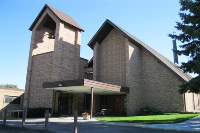By Courtney Olsen
In an age in which rhetoric around the “dying church” is prevalent and laden with emotion, less attention is focused on the ways in which churches are adapting to give new life to their congregations. Against such a backdrop and faced with low membership and subsequently lower financial contributions, First Lutheran Church of Crystal (FLCC) decided to make a big change to revitalize their ministry.

First Lutheran Church of Crystal now worships in the building sold to the Seventh Day Adventist congregation that had formerly rented space.
“It’s actually a pretty magical story,” offered the Rev. Dave Folkerts, pastor at FLCC.
Over a decade ago, FLCC was approached by a Seventh Day Adventist (SDA) congregation looking for a space to rent. Folkerts and the leadership of FLCC agreed.
“My home congregation in Lincoln, Nebraska, got their start at a SDA college,” said Folkerts. “I told them that story and how meaningful it was.”
Though they did not overlap often (the SDA congregation mostly used the space in the evenings), the two congregations got along very well in their shared building. Folkerts and the SDA pastor even preached at each other’s congregations over the years.
ABOUT FOUR YEARS ago, the SDA congregation raised the question of purchasing its own building. “Our council began to take stock about what our congregation was looking like,” explained Folkerts. “Little by little the conversation began to shift towards, ‘What if they purchased the building from us and we stayed?’”
There were benefits to selling the church building. “Our membership and financial contributions were not growing,” explained Larry Hanson, former council treasurer at FLCC. “The cost of maintaining our building had become a financial burden.”
“Our church was not growing, theirs was. We thought it would be good for us to at least talk about,” added Mariana Duffney, former director of operations at FLCC. “We thought, ‘If we can still stay in our building and continue our ministry, it frees us up to focus on the ministry.’”
FLCC’s leadership began exploring what selling the building would look like. At the same time, they hosted roundtable discussions with members to keep them informed on the exploration and answer questions. “We presented the fiscal realities of our situation. Over time, those conversations became less and less charged,” said Folkerts.
“Since the sale of the building closed in April, relatively little has changed in the relationship between the two churches.”
Eventually, the time came for a congregational meeting to make a decision about what to do with the building. A vote to sell the building and lease from the SDA congregation passed by 86%. “It was a testament to the work we had done ahead of time,” said Folkerts. “We did our homework for our members and with our members.”
Though the logistical sale of the church building drove these conversations, the focus of this change has been greater. Said Folkerts: “This is about more than the sale of a facility: it’s about establishing a new protocol for faithful witness in the community. That’s been our guiding principle through this whole process.”
SINCE THE SALE of the building closed in April, relatively little has changed in the relationship between the two churches. “We had a lot of years together before the sale,” said Folkerts. “We’ve made changes gradually and we have great lay leadership that helped keep surprises to a minimum. We have a focus on the future instead of on the jolt of the present.”
However, it is expected that results of the change will become clearer in the coming years. “It’s too soon to judge how it will change our ministry and congregation,” explained Duffney. “We’re just trying to get through the nuts and bolts of the transition. The next period of time might allow for some growth. There has always been a really good relationship between the two congregations. We coexist well, and I don’t see that changing.”
